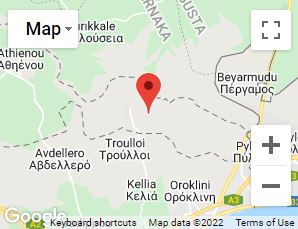Copper mine
The mine is located approximately 500 metres southeast of the village and it is the only mine of Cyprus which has been developed away from the foothills of Troodos. However, its copper deposit appears to be related to the pillow lavas of Troodos.
The conglomerate copper rust, as well as the underground mining work remains, reveal that the copper deposit was extensively exploited during the ancient years. This exploitation can be linked to the history of the ancient city of Kiti which, according to carbon-14 dating which took place in the city’s copper processing factories, begins in the 13th century B.C. The mine of Troulloi was definitely one of their suppliers, if not the most important of all suppliers.
The recent history of the mine begins back in around 1920, as is the case with all mines of Cyprus.
In parallel with copper, there were also gold deposits which were exploited by two other companies with which a contract was signed. Therefore, from 1935 to 1939, 46.9 kg of gold and 187,2 kg of silver were produced at the mine of Troulloi by W. Berdi, the company which had leased the mine. Moreover, the Greek Mining Company produced 67, 5 kg of gold and 368, 5 kg of silver at the mine of Kokkinomoutti located 3.5 km south of Troulloi. In fact, a factory was built east of the road linking Kellia with Troulloi in order to process the minerals.
From 1940 until 1952 no activity was recorded in the area. However, between 1952 and 1954, after research conducted by Berdi, a small copper deposit was traced below the gold deposit which they had previously exploited. Therefore, using the method of jet texturing 46,475 tonnes of copper were extracted from 1956 until 1961.
In 1962 the mine was leased to the Cyprus Mining Company and to American Metal Climax. The two companies merged under the naming Troulloi Mining Company. The new firm decided to construct a new factory which was completed in 1974. However, the mine’s operation ceased due to the Turkish invasion of 1974.
All in all, the operation of the mine benefited the community since several residents of the village found employment there. At the same time, early projects such as the supply of electricity and the asphalting of the road linking the community to Larnaka contributed to the growth of the community.
Source:
This text has been prepared by the Community Council.
[g-gallery gid=”674″ random=”0″ watermark=”0″]
Quarries Terra Umbra
Terra Umbra is a type of coloured rock and this rock was processed at the Terra Umbra quarries, which turned it into powder before exporting it. There are two Terra Umbra Quarries in Troulloi. The biggest one is located south of the village and is known as the Kokkini Quarry, whereas the other one is located east of the village, near the chapel of Agios Neophytos.
The beginning of their operation is dated back to around 1930 and continued until approximately 1990. Due to the excavations conducted in the area, a large cavity was created at the Kokkini Quarry, which has today turned into a lake.
In the past extraction works were very dangerous since the necessary equipment was not available, something which resulted in the occurrence of frequent accidents. On one occasion the accident was fatal after a big volume of rock and dirt fell over a worker. Finally, it is worth mentioning that during the first years of their operation the material was transported to the furnaces in the city using animal-drawn carriages.
Source:
Troulloi Community Council
[g-gallery gid=”677″ random=”0″ watermark=”0″]
Bridge stone
[g-gallery gid=”680″ random=”0″ watermark=”0″]
Cave of God Yfaistos
[g-gallery gid=”683″ random=”0″ watermark=”0″]
Wells of God Yfaistos
Chapel of Agios Neophytos
More: Religious Life



